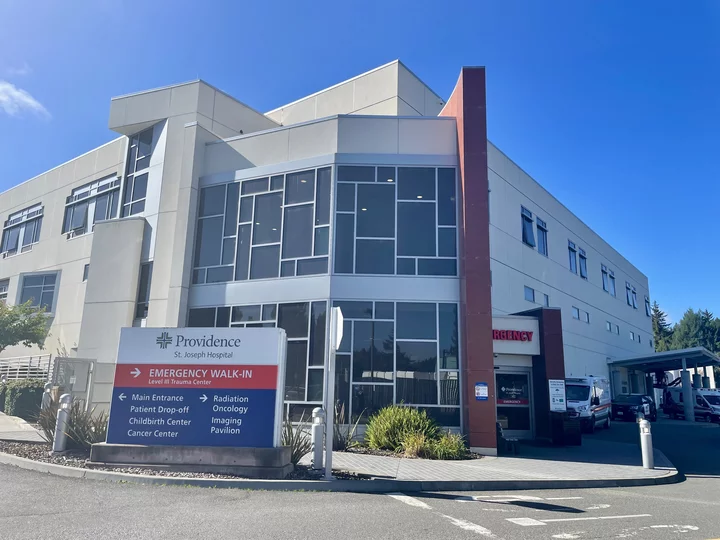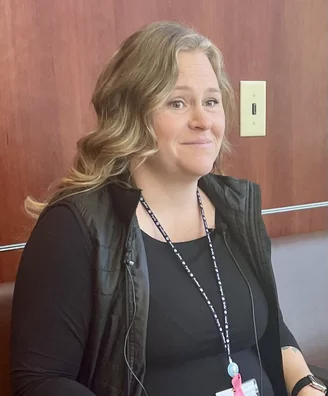The Emergency Department entrance at Providence St. Joseph Hospital. | Photos and video by Ryan Burns.
###
Michelle Flynn has been a nurse in Providence St. Joseph Hospital’s emergency department for almost a decade. The environment inside, amid the often desperate patients and hustling staff, can be described as “so much chaos,” she said in an interview earlier today.
In recent months, though, Flynn has been able to spend a lot more time with each patient, answering their questions, explaining their labs, even helping them make appointments or arrange family visits.
Ironically, perhaps, this increased level of personal engagement has been facilitated through cutting-edge technology that takes her out of the hospital entirely — physically, anyway. Working from home, Flynn appears in patient rooms virtually, her face popping up on a wall-mounted TV screen while she interacts with patients via secure, two-way audio and visual, enabled through a remote-controlled high-resolution camera.
Here’s what that looks like:
Nurse Michelle Flynn demonstrates the virtual nursing technology now in use at Providence St. Joseph Hospital.
###
Back in July, St. Joseph Hospital became the first Providence-owned medical facility to launch a virtual nursing model and hybrid approach in its Emergency Department. This pilot program combines telehealth with traditional bedside care, an approach that’s part of a broader tech-forward strategy that includes adoption of A.I.-empowered documentation and a “Physician in Triage” model that is streamlining workflows while enabling more patient-centered care, according to staff.
Kristen Hansen, director of nursing for St. Joseph’s emergency department, told a group of reporters this morning that the virtual nursing program has been a hit with both patients and staff. Participating nurses do their rounds virtually, beaming into patient rooms to handle documentation, assess their pain levels, answer questions, facilitate language interpreter services when necessary — in short, handling tasks that help to free up in-person medical staffers for direct care.
“They can help with isolation patients, so the [other] nurses don’t have to go into the rooms as often, or violent patients with behavioral health [issues],” Hansen said.
The program is also helping Providence to retain some of its most experienced nurses in Humboldt County. Working in the Emergency Department can be very physically and emotionally demanding, Hansen said. “So this [virtual nursing program] gives an opportunity for us to keep those really high-performing nurses who are highly experienced involved in emergency care even when it’s difficult for them, physically or emotionally, to keep doing that work.”
Technology is allowing these nurses to reconnect with the most meaningful aspects of their work, Hansen said.
“Everyone gets into nursing because they want to take care of patients, and then you find that so much of your time is a checklist of things. You have to document; you have to complete [administrative] tasks; you don’t get to spend that time connecting with patients as much,” she explained. “The virtual nurses all express how much they love the opportunity to connect with their patients and actually spend the time doing the work that they got into nursing to do.”
Patients have been much happier, too.
“Our patient experience metrics have gone through the roof — some of the highest they’ve been in years,” Hansen said.
Nurses in the program work from home on special Providence-issued computers built to comply with all HIPAA privacy regulations. The in-room cameras are all turned off and aimed away from patients until a virtual nurse beams in and “knocks,” then asks permission to “enter,” meaning turn the camera around and engage.
“Usually, for the most part, they say, ‘I guess so,’” Flynn told reporters from her position on one of the wall-mounted TVs. Referring back to her description of the pandemonium that often overtakes the Emergency Department, Flynn said, “Being a virtual nurse? We’re like the calm in the chaos. … I’m able to go in and, like, talk with them for as long as they’d like.”
Predictably, some patients are a bit taken aback during their initial interactions with a virtual nurse.
“They’re very, like, ‘Oh, this is weird,’” Flynn said. “But then, by the end of it, they’re like, ‘This is amazing.’”
Flynn was likewise a bit hesitant about the new approach at first. She wasn’t sure she’d like appearing remotely, but she said serving in this new role allows her to spend 20 or 30 minutes talking to individual patients.
“By doing this, I’m able to go on their chart and reassure them,” she said. “I’ve made appointments for patients that needed [them]; I have called family members. It’s very personal and it’s very, I don’t know, it’s meaningful. I actually really do enjoy doing this, and I feel like patients do as well.”
Meanwhile, St. Joseph Hospital has started using A.I. assistants to help with documentation, which saves medical staff even more time.
Below is a press release from Providence with more information:
Providence St. Joseph Hospital Eureka enhances care delivery and reduces wait times with new innovations in the Emergency Department
Eureka, Calif. — Patients arriving at the Emergency Department at Providence St. Joseph Hospital Eureka, a Level III Trauma Center, are now being seen on average in less than ten minutes of their arrival, thanks to a series of groundbreaking innovations designed to enhance the care experience, improve efficiency, and support bedside teams.
On July 17, St. Joseph Hospital Eureka became Providence’s first Emergency Department to launch a virtual nursing model and hybrid approach that blends telehealth support with traditional bedside care. This pilot program is part of a broader strategy that also includes adoption of AI technology by physicians and utilization of the Physician in Triage model to streamline workflows and enable more patient-centered care. “
These innovations are transforming how we deliver emergency care,” said Kristen Hansen, director of nursing, Emergency. “Patients are being seen faster, receiving more personalized attention, and our caregivers are feeling more supported than ever.”
Virtual nurses support ED teams
Each Emergency Department room is equipped with a mounted TV and camera, allowing virtual nurses to assist patients remotely via secure two-way audio and video. With a patient’s consent, family members or advocates can also join calls from outside the hospital.
Virtual nurses do not replace bedside nurses, they provide supplemental support handling key tasks such as admissions, discharge preparation, medication reconciliation, and patient education, freeing up bedside teams to focus on direct care.
One virtual nurse, Matthew Stevens, shared how the model is reshaping the patient experience:
“Virtual nursing allows us to return to the fundamentals of nursing, like being present, listening, educating, and advocating. In our fast-paced environment, virtual nurses can help patients feel seen and supported, while also relieving bedside caregivers of tasks like coordinating with outside facilities or facilitating interpreter-supported video calls. It’s a collaborative approach that truly enhances care.”
Patients are already noticing the difference. Vanessa Anderson, who recently visited the ED, shared her experience:
“The virtual nurse made sure I had everything I needed because they were busy; the emergency room was packed! The bedside nurse isn’t having to run around from room to room, making life easier. I was happy with my overall experience.”
Artificial Intelligence and Physician in Triage streamlines workflows
St. Joseph Hospital Eureka also utilizes an AI assistant that securely captures patient-physician conversations and automatically converts them into notes for delivery within Providence’s electronic health record in real-time. Since implementation, the ambient tool has significantly reduced administrative burdens, allowing providers to spend more of their time focused on their patients at the bedside.
In addition, the hospital now utilizes a Physician in Triage model, placing a physician at the front of the emergency department workflow, allowing patients to be assessed and treated more quickly upon arrival.
Together, these innovations are helping St. Joseph Hospital Eureka deliver faster, smarter, and more compassionate emergency care.
“We’re building this together,” Hansen said. “The response from our caregivers and patients has been overwhelmingly positive. This is a rare and exciting opportunity to shape the future of health care delivery.”
St. Joseph Hospital Eureka is proud to help lead these efforts for the broader Providence health system and welcomes feedback from the community as the pilot continues to evolve.


CLICK TO MANAGE